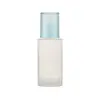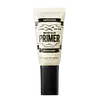What's inside
What's inside
 Key Ingredients
Key Ingredients

 Benefits
Benefits

 Concerns
Concerns

 Ingredients Side-by-side
Ingredients Side-by-side

Cyclopentasiloxane
EmollientWater
Skin ConditioningHdi/Trimethylol Hexyllactone Crosspolymer
Isododecane
EmollientDimethicone
EmollientPEG-10 Dimethicone
Skin ConditioningDimethicone Crosspolymer
Emulsion StabilisingButylene Glycol
HumectantVinyl Dimethicone/Methicone Silsesquioxane Crosspolymer
Glycerin
HumectantDimethicone/Vinyl Dimethicone Crosspolymer
Skin ConditioningPanthenol
Skin ConditioningNymphaea Caerulea Flower Water
Skin Conditioning1,2-Hexanediol
Skin ConditioningDisteardimonium Hectorite
StabilisingMagnesium Sulfate
Sorbitan Sesquiisostearate
EmulsifyingBeeswax
Emulsion StabilisingSilica
AbrasivePalmitic Acid
EmollientStearic Acid
CleansingPhloretin
AntioxidantSilica Silylate
EmollientAlcohol Denat.
AntimicrobialBakuchiol
AntimicrobialCI 77220
Cosmetic ColorantAsiaticoside
AntioxidantMadecassic Acid
Skin ConditioningAsiatic Acid
Skin ConditioningCitrus Unshiu Peel Extract
MaskingParfum
MaskingBenzyl Benzoate
AntimicrobialBenzyl Salicylate
PerfumingLinalool
PerfumingAlpha-Isomethyl Ionone
PerfumingGeraniol
PerfumingLimonene
PerfumingHydroxycitronellal
PerfumingCoumarin
PerfumingCyclopentasiloxane, Water, Hdi/Trimethylol Hexyllactone Crosspolymer, Isododecane, Dimethicone, PEG-10 Dimethicone, Dimethicone Crosspolymer, Butylene Glycol, Vinyl Dimethicone/Methicone Silsesquioxane Crosspolymer, Glycerin, Dimethicone/Vinyl Dimethicone Crosspolymer, Panthenol, Nymphaea Caerulea Flower Water, 1,2-Hexanediol, Disteardimonium Hectorite, Magnesium Sulfate, Sorbitan Sesquiisostearate, Beeswax, Silica, Palmitic Acid, Stearic Acid, Phloretin, Silica Silylate, Alcohol Denat., Bakuchiol, CI 77220, Asiaticoside, Madecassic Acid, Asiatic Acid, Citrus Unshiu Peel Extract, Parfum, Benzyl Benzoate, Benzyl Salicylate, Linalool, Alpha-Isomethyl Ionone, Geraniol, Limonene, Hydroxycitronellal, Coumarin
Water
Skin ConditioningMethyl Methacrylate Crosspolymer
Butylene Glycol
HumectantPentylene Glycol
Skin ConditioningSodium Acrylates Crosspolymer-2
AbsorbentNiacinamide
SmoothingArtemisia Vulgaris Oil
PerfumingAmmonium Acryloyldimethyltaurate/Vp Copolymer
Sodium Acrylate/Sodium Acryloyldimethyl Taurate Copolymer
Emulsion StabilisingGlyceryl Caprylate
EmollientEthylhexylglycerin
Skin ConditioningPolyisobutene
Adenosine
Skin ConditioningSorbitan Oleate
EmulsifyingCaprylyl/Capryl Glucoside
CleansingGlycerin
HumectantTocopherol
Antioxidant1,2-Hexanediol
Skin ConditioningSodium Hyaluronate
HumectantBeta-Glucan
Skin ConditioningHydrolyzed Hyaluronic Acid
HumectantSodium Acetylated Hyaluronate
HumectantWater, Methyl Methacrylate Crosspolymer, Butylene Glycol, Pentylene Glycol, Sodium Acrylates Crosspolymer-2, Niacinamide, Artemisia Vulgaris Oil, Ammonium Acryloyldimethyltaurate/Vp Copolymer, Sodium Acrylate/Sodium Acryloyldimethyl Taurate Copolymer, Glyceryl Caprylate, Ethylhexylglycerin, Polyisobutene, Adenosine, Sorbitan Oleate, Caprylyl/Capryl Glucoside, Glycerin, Tocopherol, 1,2-Hexanediol, Sodium Hyaluronate, Beta-Glucan, Hydrolyzed Hyaluronic Acid, Sodium Acetylated Hyaluronate
Ingredients Explained
These ingredients are found in both products.
Ingredients higher up in an ingredient list are typically present in a larger amount.
1,2-Hexanediol is a synthetic liquid and another multi-functional powerhouse.
It is a:
- Humectant, drawing moisture into the skin
- Emollient, helping to soften skin
- Solvent, dispersing and stabilizing formulas
- Preservative booster, enhancing the antimicrobial activity of other preservatives
Butylene Glycol (or BG) is used within cosmetic products for a few different reasons:
Overall, Butylene Glycol is a safe and well-rounded ingredient that works well with other ingredients.
Though this ingredient works well with most skin types, some people with sensitive skin may experience a reaction such as allergic rashes, closed comedones, or itchiness.
Learn more about Butylene GlycolGlycerin is already naturally found in your skin. It helps moisturize and protect your skin.
A study from 2016 found glycerin to be more effective as a humectant than AHAs and hyaluronic acid.
As a humectant, it helps the skin stay hydrated by pulling moisture to your skin. The low molecular weight of glycerin allows it to pull moisture into the deeper layers of your skin.
Hydrated skin improves your skin barrier; Your skin barrier helps protect against irritants and bacteria.
Glycerin has also been found to have antimicrobial and antiviral properties. Due to these properties, glycerin is often used in wound and burn treatments.
In cosmetics, glycerin is usually derived from plants such as soybean or palm. However, it can also be sourced from animals, such as tallow or animal fat.
This ingredient is organic, colorless, odorless, and non-toxic.
Glycerin is the name for this ingredient in American English. British English uses Glycerol/Glycerine.
Learn more about GlycerinWater. It's the most common cosmetic ingredient of all. You'll usually see it at the top of ingredient lists, meaning that it makes up the largest part of the product.
So why is it so popular? Water most often acts as a solvent - this means that it helps dissolve other ingredients into the formulation.
You'll also recognize water as that liquid we all need to stay alive. If you see this, drink a glass of water. Stay hydrated!
Learn more about Water